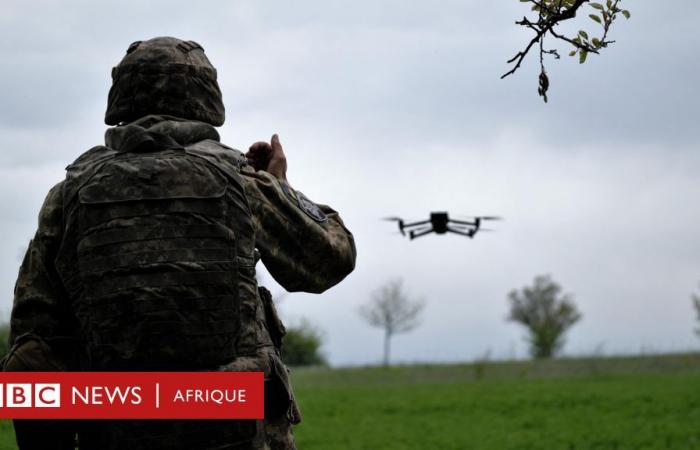
Photo credit, Getty Images
- Author, Pavel Aksenov, Oleh Chernysh and Jeremy Howell
- Role, BBC World Service
-
14 minutes ago
In recent days, Russia and Ukraine have carried out their largest drone attacks against each other since the start of the war in February 2022.
Ukraine reportedly launched more than 80 drones against Russia, some of which were aimed at Moscow. Russia has reportedly launched more than 140 drones on targets in Ukraine.
The extensive use of drones as attack weapons is one of the ways warfare is being revolutionized in this conflict.
Combined with electronic warfare and artillery attacks, drones have also proven to be very effective as defensive weapons, helping to immobilize enemy forces on the battlefield.
Drones: Eyes that see everything on the battlefield
Photo credit, Getty Images
According to Phillips O’Brien, professor of war studies at the University of St Andrews, Scotland, drones have become a major part of the war in Ukraine and are profoundly influencing the way it is fought.
“They made the battlefield much more transparent,” he explains.
Surveillance drones can spot troop movements or preparations for an attack across the entire front line in real time. When they see a target, they can send its coordinates to a command center, which can then order an artillery strike.
This sequence – from observing a target to striking it – is called the “death chain” in military terminology, and it has been significantly accelerated by the use of drones, Professor O’Brien explains.
“Everything is spotted, unless you’re in cover. This means you can’t mass tanks and other armor into an advance without them being hit,” he explains.
Photo credit, Getty Images
Attack drones are used, alongside artillery, to strike the enemy. Ukrainian forces managed to repel the advances of Russian tank columns using only drones.
Early in the war, Ukraine used the Turkish-made TB-2 Bayraktar, a military-grade drone that can drop bombs and fire missiles.
However, both sides are increasingly turning to cheaper “kamikaze” drones.
These are often commercial drones with explosives attached. They can be controlled from several kilometers away and can hover over their target before striking.
Photo credit, Getty Images
Russia also uses thousands of kamikaze drones, such as the Iranian-made Shahed-136, to strike military and civilian targets in Ukraine.
It often uses them in swarms to try to overwhelm Ukraine’s air defenses.
Photo credit, Getty Images
Artillery: The weapon that armies “use like water”
Artillery has become the most widely used weapon in the war in Ukraine.
According to the UK-based think tank the Royal United Services Institute (Rusi), Russia fired around 10,000 shells per day and Ukraine fired between 2,000 and 2,500 per day.
Artillery is used continuously to control the movements of enemy troops and to strike their armored vehicles, defenses, command posts and supply depots.
“During war, ammunition is like water, which people have to drink regularly, or like fuel for a car,” explains Colonel Petro Pyatakov, artillery expert and military specialist of ВВС.
Photo credit, Getty Images
Both sides used millions of artillery shells from abroad. The United States and European countries supplied them to Ukraine. Russia imports them from North Korea.
Western countries have struggled to supply Ukraine with all the shells it needs, highlighting the problem in their own arms industries, according to Justin Crump, chief executive of Sibylline, an arms company. UK-based defense analysis.
“Western defense companies today produce a relatively small number of high-precision weapons,” he explains. “On the other hand, they do not have the capacity to produce basic weapons such as shells in large quantities.
Russia and Ukraine have also used high-precision artillery. Ukraine has fired Western satellite-guided shells, such as Excalibur, and Russia, laser-guided Krasnopol shells.
The United States and other Western countries also supply Ukraine with long-range, satellite-guided Himars missiles. These missiles allowed the Ukrainian armed forces to attack Russian ammunition depots and command posts located behind the front line.
Glide Bombs: Simple, destructive and difficult to counter
Photo credit, Getty Images/Russian Defense Ministry
Since the start of 2023, Russian forces have used thousands of “glider bombs” to bombard Ukrainian battlefield positions and strike residential areas and civilian infrastructure.
These are conventional “free-fall” bombs equipped with fold-out wings and satellite navigation systems.
Russia is the country that uses the most glide bombs. Their weight varies from 200 kg to 3,000 kg or more.
“Glide bombs are becoming more and more effective in breaking down fortified positions and destroying buildings,” explains Professor Justin Bronk, air warfare expert at Rusi.
According to him, Russia used them extensively to destroy Ukrainian defenses around the strategically important town of Adviivka in eastern Ukraine, which it captured in February 2024.
Photo credit, Getty Images/Russian Defense Ministry
According to Professor Bronk, the glide bombs cost only $20,000 or $30,000 each. They can be launched tens of kilometers from their target and are difficult to shoot down except with the most sophisticated air defense missiles.
Photo credit, Reuters
Ukraine also uses glide bombs supplied by the United States and France, such as the long-range Joint Standoff Weapon. It has also created its own bombs by attaching wings to small-diameter bombs made in the United States, which carry around 200 kg of explosives.
However, it has fewer glide bombs than Russia.
Electronic warfare: A cheap way to neutralize the most expensive weapons
Photo credit, Getty Images
Electronic warfare has been used more intensively than ever before in the conflict between Russia and Ukraine.
Thousands of soldiers from each side work in specialized units, trying to disable the other side’s drones and communications systems, and knock enemy missiles off target.
Russian forces have systems such as the Zhitel, which can disable all satellite communications, radio communications and mobile phone signals within a radius of more than 10 km. It overpowers the radio waves they use by emitting huge pulses of electromagnetic energy.
Thanks to the Shipovnic-Aero unit, Russian forces can shoot down a drone from 10 km away. This system also helps locate drone pilots and send coordinates to artillery units so they can shoot at them.
Photo credit, Getty Images
Western nations may have been shocked at how easily Russian electronic warfare systems disabled high-tech missiles such as the Himars, according to Marina Miron of the War Studies Department at King’s College London. in Ukraine.
“This is an asymmetric war,” she explains. “NATO forces may have technically superior weapons to those of Russia, but the latter has shown that it can use relatively cheap electronic kit to neutralize them.
Duncan McCrory of the Freeman Air & Space Institute at King’s College London says NATO military leaders need to learn lessons from Russia’s electronic warfare in Ukraine.
“They have to train their troops how to operate when they are being stalked by drones and the enemy is listening to every radio signal they send,” he explains.
“Electronic warfare can no longer be treated as an afterthought. It must be taken into account when developing tactics, training and new weapon systems.





